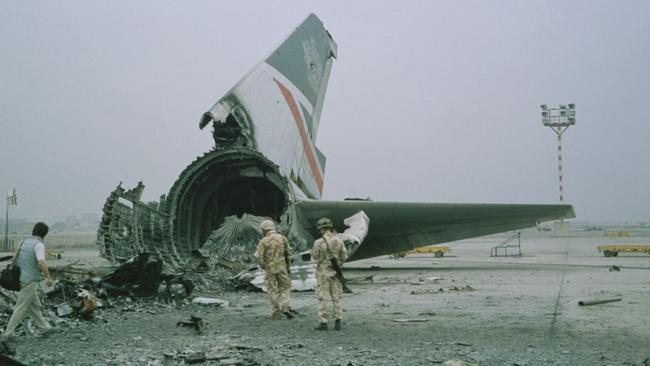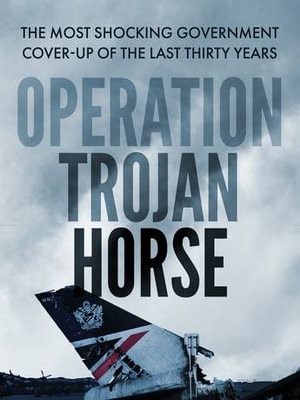The secrets of Flight 149
A clumsy, shockingly pointless, covert military operation exposed the innocent passengers of British Airways Flight 149 to rape and murder after being taken hostage in Iraq.

British Airways Flight BA149, which left London’s Heathrow Airport on Wednesday, August 1, 1990, bound for Kuala Lumpur, was always due to stop in Kuwait but, just hours before it landed, neighbouring Iraq launched a full-scale invasion, marking the start of the first Gulf War.
The 360 or so passengers and 18 crew found themselves being taken hostage by Iraqi forces in a war zone.
Journalist Stephen Davis has spent much of the past 30 years finding out the secrets behind Flight 149. His book Operation Trojan Horse is a gripping study of what is now routinely referred to as the “collateral damage” caused by government decision-making in war.
He argues that the Thatcher government knew that Flight 149 was heading into danger when it flew into Kuwait, but withheld the information, prioritising a secret intelligence mission over the safety of civilian passengers and crew. He also believes that British Airways, under the leadership of its pro-Thatcher chairman, Lord King, connived in the operation.

The dangers of being caught by the invading Iraqis were all too real: some hostages were raped, at least one was killed. Almost all were badly traumatised by the experience.
How much did Britain know about the looming danger? Just before the doors closed, before the plane departed London, “nine or 10 muscular, clean-cut young men” arrived, raising eyebrows among the other passengers, who had already been held up for two hours due to an alleged equipment fault. The men, conspicuous for their crew cuts and military bearing, made their way to the back of the aircraft. The lads were a British special forces team dispatched to Kuwait to supply “humint” – human intelligence – on the imminent invasion of Kuwait by Saddam’s Iraq. But between the time the aircraft left London and the time it landed in Kuwait, the invasion went from being imminent to being under way, which is how Flight 149’s passengers and crew became hostages.

Iraqi forces used them as “human shields” at strategic sites – airports, dams – in both Iraq and Kuwait. Some were more fortunate than others in how they were treated.
Davis describes how Iraqi Shammon Batani Roel, the resident engineer at Dokan Dam in northern Iraq, served his anxious hostages tea on the lawn and even let them have a short-wave radio so that they could listen to the BBC World Service – humane gestures that were “not without personal risk to Roel”.
The dam guards were not so amiable, brandishing their weapons and on one occasion threatening to kill hostage Barry Manners. Thrown together by chance, Roel and Manners became lifelong friends (for more on this, see the story in our news pages today). Roel eventually fled Iraq and now lives in exile in Sydney with his family.

The most compelling part of the book consists of vivid testimony drawn, we are told, from hundreds of interviews, about the plight of individuals and families trying to stay out of the hands of sexually predatory and often trigger-happy Iraqi troops.
Some were rounded up quickly while others went to ground, stocking up on water and canned food and hoping to lie low until rescued.
Several busloads were transported across the border to enjoy Saddam’s hospitality in Baghdad while a reckless few attempted to escape across the desert into neighbouring Saudi Arabia. Suffice to say, the senior BA staff who deserted their colleagues and passengers to make their own dash for safety do not come out of the book well.
Davis does an excellent job of conveying the fearfulness and indecision of hostages torn between staying put and trying to escape. Some readers, however, might find themselves skipping long extracts from personal diaries which, while undoubtedly authentic, are sometimes too mundane to be of much interest.
Neither the British Government nor BA has ever come clean about Flight 149.
As for the supposedly vital intelligence that provided the rationale for the mission, Davis suggests that it was wilfully misinterpreted to justify strategic decisions already made by the UK and US governments.
Is this, as the publisher proclaims, “the most shocking and unforgivable government cover-up of the last 30 years”? Given what we now know about the weapons of mass destruction dossier that triggered the second Gulf War, the answer is “probably not”.
It is, however, an expertly researched study of government duplicity in the service of a poorly planned, clumsily executed (the airline tickets for the special forces team were traced back to a military account linked to the SAS) and ultimately pointless covert military operation.
The ill-omened Boeing 747 was blown up on the tarmac, not by Iraqis retreating in the face of Coalition forces but by US fighter planes at the request of an embarrassed British Government.
BA received a hefty insurance payout for the plane while the passengers and crew who became Saddam’s human shields were denied compensation. Funny, that.
Tom Gilling’s last book was Bastard behind the Lines.
Operation Trojan Horse

To join the conversation, please log in. Don't have an account? Register
Join the conversation, you are commenting as Logout